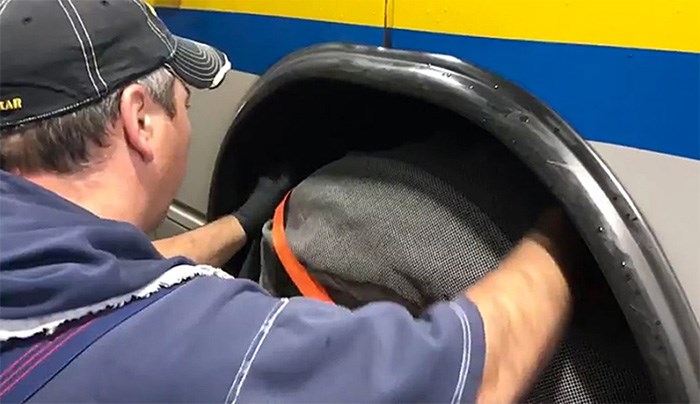 A maintenance worker demonstrates the installation of a fabric cover called a tire sock that will be piloted on buses heading up to SFU. They are used in other jurisdictions with success to prevent buses from slipping on snow and ice. Photograph By TRANSLINK VIDEO
A maintenance worker demonstrates the installation of a fabric cover called a tire sock that will be piloted on buses heading up to SFU. They are used in other jurisdictions with success to prevent buses from slipping on snow and ice. Photograph By TRANSLINK VIDEO
Catching the bus or SkyTrain in winter shouldn’t mean delays to commuters, acknowledged TransLink, and new measures should make a difference, maintenance staff said as a plan to winterize the fleet was rolled out Thursday.
Among the immediate beneficiaries will be SFU students and staff because buses heading up Burnaby Mountain to the campus will be outfitted with tire socks to provide better grip.
The fabric covers have been used in other jurisdictions and take only a few minutes to install. It will be a pilot project launched this year.
Other measures will keep Canada Line, the Expo Line and Millennium Line running, according to TransLink and will avoid a repeat of 2016/17 when there were delays.
Here’s what TransLink will undertake this year as winter approaches:
• Heat tracing is being installed on the power rail of the Canada Line in sections where heavy ice buildup led to service disruptions in February 2017. Cover-boards are also being installed, to protect the power rail from snow buildup. Both will reduce risk of ice.
• On SkyTrain de-icer spray trains are used to keep the power rail free of ice. De-icing stations are set up in covered areas and tunnels to prevent ice and snow compacts on the trains. During times of overnight snow, some SkyTrain cars will run throughout the night to keep tracks clear.
• Canada Line anti-icing and sanding will ensure the power rail and tracks are clear of ice. Canada Line cars have a braking system similar to ABS brakes on your vehicle which helps avoid slippage.
• Extra staff including SkyTrain attendants and Transit Police will assist customers in getting where they need to go.
• An arborist is reviewing all trees and branches within 10 metres of the SkyTrain tracks. In partnership with CP, the same work is occurring for West Coast Express tracks. ?
• Anti-icing trucks will spray an anti-icing agent to the entire 300-km electric trolley overhead system if there is risk of frost or ice.
• Operators have a snow/ice switch which gives the bus tires better traction in snow.
• If needed, articulated buses will be switched out for traditional buses, which have better traction on hills in snow.
• TransLink also plans to work with municipalities to coordinate priority corridors for snow clearing, should conditions become severe.
• For those relying on HandyDart, TransLink staff have contacted day program operators to make them aware of HandyDART requirements for salting, sanding and access. When conditions require reduction to essential service, two drivers go out with each bus to assist customers with loading and unloading.


